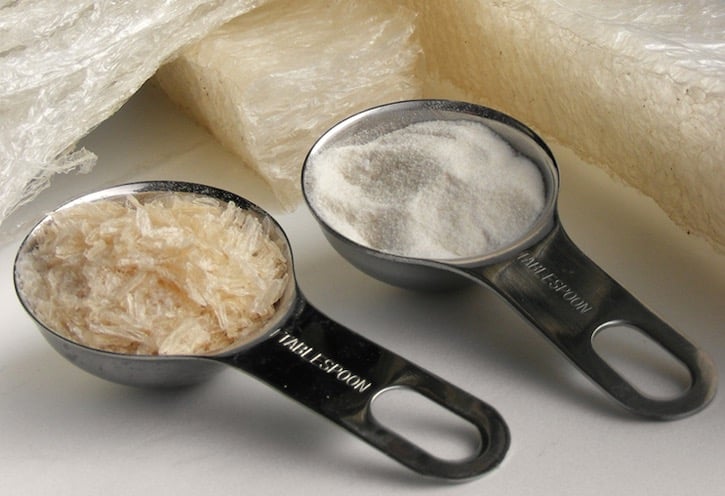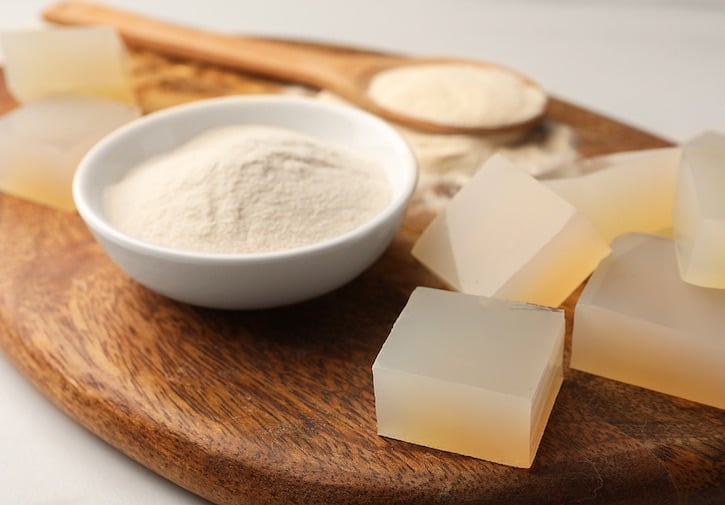Agar, from the Malay word meaning “jelly,” is a seaweed-based product long appreciated by many Eastern cultures for its gelling properties. Also known as agar-agar, this a natural plant-derived gelling agent. This guide offers helpful tips and ideas on how to use agar, with links to vegan recipes.

Agar is typically used to make jellies, puddings, and gummy candies, or as a thickening additive in ice cream, pudding, and sorbet. It’s a useful plant-based ingredient in vegan cooking that can take the place of eggs or conventional gelatin.
Various Forms of Agar & How to Use Them
Available in several forms, the most widely marketed is the powder. There are also bars, sold tightly wrapped in cellophane and flakes, sold in small cellophane packages. Look for agar products in natural foods stores, Asian groceries, and online sources.
Conversion: 1/2 agar bar = 1 tablespoon flakes = 1 teaspoon powder – These ratios are a loose guide to understanding the strength of each form.
Agar bars
Agar bars have been in use for longer than the flakes and are made from a combination of several different red seaweeds belonging to the botanical family Gelidium. The method used to produce the bars is a long, tedious one that has changed little throughout the centuries since its discovery.
How to use agar bars: One agar bar will gel up to 3 cups of liquid. Use slightly less liquid if a firmer gel is desired. Break the bar up into several pieces and combine it with liquid in a saucepan. Bring to a boil, then lower the heat and simmer for 15 minutes, stirring occasionally.
Agar flakes
Agar flakes are a product that is somewhat more convenient to use than the bars, containing a more concentrated, stronger gel. In either case, the gelatin yielded is flavorless, odorless, and colorless, making agar a product with endless possibilities.
How to use agar flakes: One tablespoon of agar flakes will gel 1 cup of liquid. In a small saucepan, bring the liquid to a slow boil. Sprinkle in the flakes, then lower the heat and simmer for 4 to 5 minutes, stirring occasionally. The liquid used may be water, fruit juice, vegetable juice, or bouillon, depending on the needs of the recipe.
Agar powder
Agar powder is currently the most popularly used form of powder because it is the most concentrated and disolves the most easily. Powdered for provides the most constrol and consistent results.
How to use agar powder: For 1 cup of liquid or a firm gel, use 1 teaspoon of powder. For a soft, loose gel use 1/2 teaspoon; and for just light thickening use 1/4 teaspoon.
In a small saucepan, bring liquid to a slow boil, sprinkle in the powder, and stir while simmering. Agar powder will dissolve quicker than other forms, and only needs to be stired for 2 to 3 minutes.
These are general notes; you will always find more specific directions on how to use any of these forms of agar in recipes that call for them.

Agar flakes and powder (photo courtesy of flickr)
Cooking Notes
Once prepared in the method described above, other flavorings and solid ingredients may be added to make aspics and puddings. Pour whatever mixture you’ve made into a heatproof bowl and chill thoroughly, refrigerated, for at least 2 hours.
The consistency, once chilled, resembles that of a firm pudding, though not quite stiff enough to be cut into squares or molded the way you could commercial gelatin.
Certain substances interfere with the gelling action of agar. It will not be set in the presence of acetic acid (found in vinegar) or oxalic acid (found in chocolate and spinach). With other acidic substances, such as pineapple or tomato juice, the agar will set, but not as firmly as it might otherwise.
Nutrition Notes
Agar has virtually no calories. At 75 percent carbohydrate, it is high in the form of fiber that passes through the body undigested, adding bulk to the diet.
Although it is not quite as rich in nutrients as other sea vegetables, it does contain iron, calcium, potassium, and iodine, as well as a number of vitamins, including B6, B12, C, D, and K. There is a full look at the nutritional facts of agar here.

Easy Ways to Use Agar
Agar bars or flakes are easy and fun to experiment with. Use the proportions of agar to liquid given above. Here are just a few ways to try it:
Cook agar in 1 cup of pineapple juice. Allow to cool to room temperature. Stir in 1 cup each of plain yogurt and crushed pineapple. Flavor with 2 to 3 tablespoons of honey and stir together. Pour into individual serving cups or into a glass bowl and chill for at least 2 hours. Serve as part of a light lunch or as dessert. This makes 4 servings.
Cook agar in 1/2 cup apple cider, then add an equivalent amount of applesauce and a pinch each of cinnamon and nutmeg. Chill for at least 2 hours, then use as a spread for breads and muffins.
Gelled stewed fruit compotes. Cook agar in 1 cup of fruit juice and combine with 2 cups or so of stewed fruits. Chill for at least 2 hours. Agar makes great vegetable aspics.
Gelled cold soups. Try gelling your leftover gazpacho, or other brothy vegetable soups. Strain the liquid from the soup and cook it with the proper amount of agar. Stir in the solid ingredients, pour into a container, and chill for at least 2 hours. A cooling vegan vegetable aspic!
Ideas for Cooking with Agar
- Coconut Jelly Duo: Refreshing traditional Thai dessert of layered coconut jelly.
- Mango Coconut Jelly Cubes: A vibrant flavorful layered jelly inspired by the previous traditional Thai dessert.
- Vegan Panna Cotta: A plant-based version of the sweet and creamy classic Italian dessert.
- Vegan Marshmallows: Perfect for toasting, and without all of the processed ingredients.
- Sliceable Chashew Cheese: Flavorful vegan cheese featuring tahini and dijon mustard.
- Vegan Cheese (No Nuts): Provolone-style cheese without nuts or oils!
- Vegan Aspic: This French savory gelatin, popularized in the 1950s could make a comeback. Better yet, in a vegan version!
- Vegan Strawberry Cheesecake: This cashew based creamy dessert is stunningly pink and would make a vibrant party dessert.
- Key Lime Pie: Bright, summery, easy-to-make custard pie with simple ingredients.
- Vegan Deviled Eggs: A plant-based alternative with an uncanny resemblance to the original.
See more of our Good Food Guides.

Leave a Reply